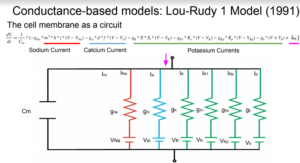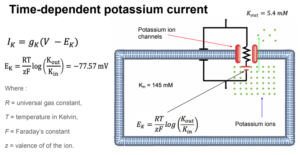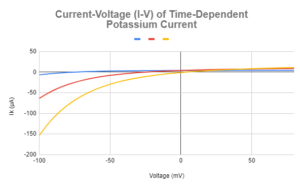Welcome to the LAST blog of my computational biology internship experience at University of California, Davis, School of Medicine in the Department of Physiology and Membrane Biology! This week, we rotated to Dr. Colleen Clancy’s Laboratory to explore Ventricular Action Potentials to see how the pertinent Potassium Ion channel can have different voltages applied to it and how that affects its current; all of this, possible by coding a mathematical model that expresses the Current vs Time relationship and converts it to Current vs Voltage in the form of numerical data with the C++ programming language.
We continued to work with PhD Candidate John Dawson as our mentor, but we also met PhD Candidate Gonzalo Hernández-Hernández, PhD Candidate Adam Rose, and PhD Student Brightany Li. All of them are excellent professionals who have shown me that collaboration is essential in science and that we are not limited to what we do in high school or undergraduate studies because that is just the beginning for intensive scientific research opportunities. I admire the passion and commitment with which my mentors present their research interest and the internship material since that is something amazing to see in a person (that they love what they do). I am very grateful to have had the opportunity to meet so many incredible professionals and the other interns. I believe we have come to know each other very well and those connections are very important and meaningful.
On Monday, we had a Zoom meeting to get to know each other, mentors and interns, better. My mentors briefly introduced the objective of the internship, which was to study the time-dependent potassium current by using C++ to code “certain interactions”. I was unsure about being able to learn such complicated information as well as to being able to apply it in just a week. Incredibly, I am now very proficient with the information my mentors gave me and I am able to understand its technical aspects. This has shown me that nothing is impossible and motivation is the first thing needed to succeed in any situation.
On Tuesday we went over the theoretical and experimental details of the internship. Mr. Rose explained the very complicated mathematical model used to represent the cell membrane as a circuit. There were many details I was not able to grasp instantly, but it all came together after reading about and understanding the biophysics behind the model.
In short, the model emerges from manipulations (using Calculus and algebraic-substitutions) of the charge of the cell equation. Eventually, that simple linear equation became a very complicated model that I was, eventually, able to understand conceptually and mathematically, for the most part.
This is a picture of the full mathematical model Mr. Adam Rose presented:
However, being able to code all of the ion channels’ currents takes several weeks of preparation. It was time we didn’t have and, so, the reason why we concentrated on the potassium channel.
This is the equation of the time-dependent potassium channel and how it is represented as a Circuit:
The coding representing the circuit was, in simple terms, solving multiple differential equations by taking the integral of the current’s derivative at different instants in time.
It was very complicated to understand all of the concepts in just a day (since it is usually distributed along 4 weeks for undergraduate students that intern during the summers), but Mr. Dawson and Mr. Hernández-Hernández gave me many resources and recommendations so I could understand all concepts effectively.
On Wednesday we went over the coding we had the task of transcribing into our own computers to, then, run it in Repl.it. We were going to compile the C++ code manually, but due to time constraints we used that amazing online tool, which I intend to keep using to improve my coding capabilities. Ms. Li explained what each line of the coding meant. I am very glad that she explained everything since that really helped clear many doubts I had as to why the code was structured as it was. I learnt many technical aspects of the language that are rarely acquired through video tutorials, but by experience, and I am glad she shared her knowledge with us.
Coding is, ultimately, a very useful tool that scientists can now use due to all of the experiments and information that has been collected throughout the years. However, our mentors emphasized the importance of teamwork and, although they recommended we learn how to code early in our undergraduate studies, they said that it isn’t something that will determine our value as researchers. They suggested that if we do not enjoy coding we can always team up with others with expertise in that area. I do intend to learn how to code since I think it is important to use computers for faster scientific research and advancements. However, I do believe that the importance of science is the abstract and complex thinking we as humans can achieve. Computers are merely excellent tools that aid us in lengthy and repetitive processes, but we are responsible for the real results and progress.
On Thursday, I collected all of the data points the code had output and I used spreadsheet software, Google Sheets, to plot the Current vs Voltage relationship in the time-dependent potassium ion channel.
Here is a picture of the Labeled Graph:
On Friday we had an internship conclusion meeting (concerning the rotation from Dr. Igor Vorobyov’s Lab to Dr. Colleen Clancy’s Lab). It was great to conversate about my experience and to receive feedback from all of the mentors we have had in this second-section of the internship. I have learnt incredible things about the world of scientific research that I will remember for the rest of my life. I am glad that this internship didn’t only help me advance my scientific knowledge in a field, but helped me with many life and career decisions I will have to make in the following years.
I am very grateful for this opportunity. Thanks to The Pinhead Institute for this great connection and thanks to all of my mentors, who have been extremely helpful and supportive. I want to especially thank Dr. Vladimir Yarov-Yarovoy, Dr. Igor Vorobyov, and Dr. Colleen Clancy for making this opportunity possible during this challenging situation we are going through. Thanks to Mr. Brandon Harris, Dr. Slava Bekker, Mr. John Dawson, Mr. Gonzalo Hernandez-Hernandez, Ms. Brightany Li, and Mr. Adam Rose for their excellent mentoring and for helping me whenever I needed.
This is the last week of this incredible internship experience, and I can’t wait for what the future holds for me and my fellow interns. Thanks to Carmen Puentes-Flores and Kelly Stellmacher, also 2020 Pinterns, for all their support and for being great human beings.
When I was not in my internship I spent most of my time studying for the SAT (which approaches slowly, but dangerously), advancing in my AP Calculus BC course, and re-reading the book “Six Easy Pieces”, by Richard Feynman, since it has many quotes I want to remember and a lot of valuable information from the genius lectures Richard Feynman gave.
I also volunteered on Friday, July 17th, for Pinhead’s Science of Cocktails. I helped prepare the ingredient bags and with other needed tasks. It was great to get to meet other interns and see that we can still collaborate under these social distancing laws.




There are no comments published yet.